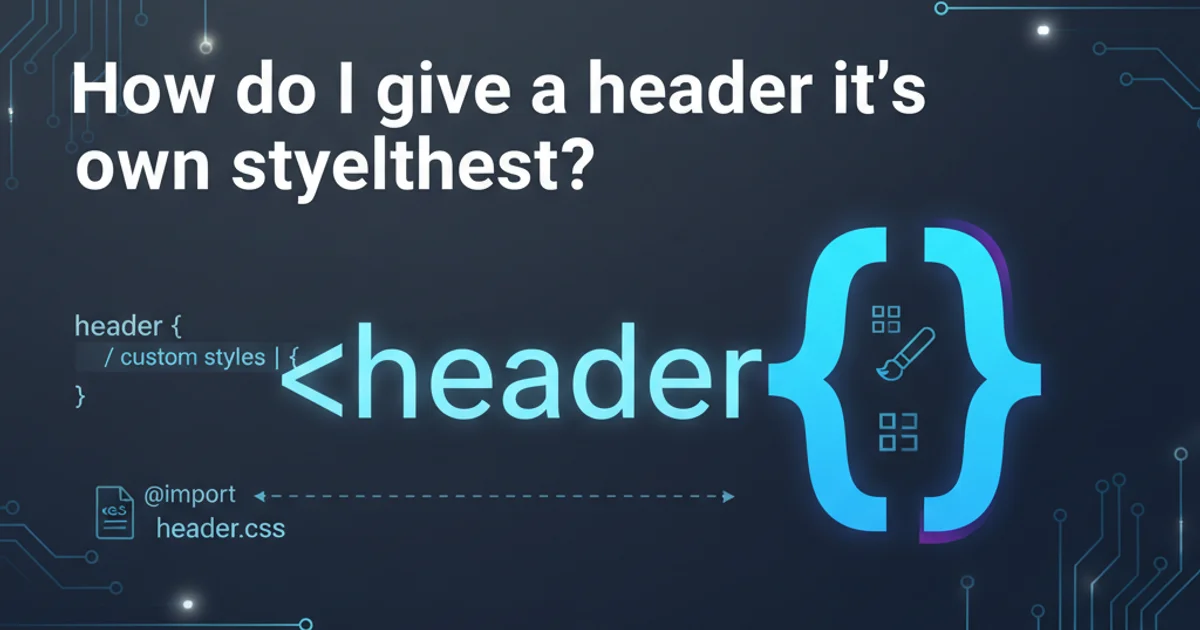How do I give a header it's own stylesheet?
Categories:
Styling HTML Headers with Dedicated CSS

Learn how to apply unique and specific styles to HTML header elements (
,, etc.) using various CSS techniques, ensuring precise control over your page's typography and layout.
HTML headers are crucial for structuring content and improving readability. While global CSS rules can style all headers, you often need to apply unique styles to specific headers or groups of headers. This article explores different methods to give your headers their own distinct stylesheets or style rules, ranging from inline styles to external stylesheets and advanced CSS selectors.
Understanding CSS Specificity for Headers
Before diving into implementation, it's important to understand CSS specificity. Specificity determines which CSS rule gets applied when multiple rules target the same element. A more specific rule will override a less specific one. This concept is key to successfully applying unique styles to your headers without unintended conflicts.
flowchart TD
A["HTML Element (e.g., <h1>)"] --> B{"Is there an inline style?"}
B -->|Yes| C["Apply Inline Style (Highest Specificity)"]
B -->|No| D{"Are there ID selectors?"}
D -->|Yes| E["Apply ID Style"]
D -->|No| F{"Are there Class/Attribute/Pseudo-class selectors?"}
F -->|Yes| G["Apply Class/Attribute/Pseudo-class Style"]
F -->|No| H{"Are there Type/Pseudo-element selectors?"}
H -->|Yes| I["Apply Type/Pseudo-element Style"]
H -->|No| J["Apply Universal Selector/Inherited Style (Lowest Specificity)"]
C --> K[Final Rendered Style]
E --> K
G --> K
I --> K
J --> KCSS Specificity Hierarchy for Style Application
Methods for Styling Individual Headers
There are several ways to apply styles to headers, each with its own use case and level of specificity. Choosing the right method depends on whether you need a one-off style, a reusable style, or a style based on context.
Inline Styles
My Unique Header
Internal Stylesheet
Another Special Header
External Stylesheet
Section Title
/* In styles.css */ .section-title { color: purple; border-bottom: 1px solid purple; padding-bottom: 5px; }
Advanced Styling with CSS Selectors
Beyond basic ID and class selectors, CSS offers powerful ways to target headers based on their attributes, position, or parent elements. This allows for highly contextual and flexible styling without adding excessive classes to your HTML.
/* Target an h2 directly following an h1 */
h1 + h2 {
margin-top: 0;
color: #555;
}
/* Target any h3 inside a specific div */
.content-area h3 {
font-style: italic;
border-left: 3px solid orange;
padding-left: 10px;
}
/* Target an h4 with a custom data attribute */
h4[data-status="draft"] {
color: gray;
font-weight: normal;
}
/* Target the first h1 on the page */
h1:first-of-type {
text-transform: uppercase;
letter-spacing: 2px;
}
Examples of advanced CSS selectors for header styling
[data-status="draft"] can be very effective for semantic styling without relying on generic class names. This improves code readability and maintainability.Organizing Your Header Styles
For larger projects, it's beneficial to organize your CSS effectively. Consider using a modular approach where header styles are grouped logically. This could involve separate CSS files or sections within a single file dedicated to typography or specific components.
1. Create a dedicated CSS file
For complex projects, create a separate CSS file (e.g., _typography.css or _headers.css) to house all your header-related styles. This keeps your main stylesheet cleaner.
2. Import into main stylesheet
Use the @import rule in your main CSS file to pull in the dedicated header styles. Alternatively, link multiple stylesheets directly in your HTML <head>.
3. Use a consistent naming convention
Adopt a consistent naming convention for your classes and IDs (e.g., BEM methodology) to avoid conflicts and make your CSS easier to understand and maintain.
4. Leverage CSS variables
Define common properties like font-family, font-size, and color as CSS variables. This allows you to easily update styles across all headers from a single point.